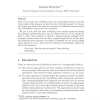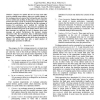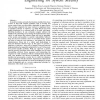270 search results - page 37 / 54 » Verifying Second-Level Security Protocols |
ENTCS
2006
13 years 8 months ago
2006
There are two main ways of defining secrecy of cryptographic protocols. The first version checks if the adversary can learn the value of a secret parameter. In the second version,...
ISCN
2006
IEEE
14 years 2 months ago
2006
IEEE
Suppose two entities that do not trust each other want to exchange some arbitrary data over a public channel. A fair exchange protocol ensures that both parties get what they want ...
ICC
2007
IEEE
14 years 3 months ago
2007
IEEE
— In modern wireless networks the functions included into layer II have to deal with complex problems, such as security and access control, that were previously demanded to upper...
JDCTA
2010
13 years 3 months ago
2010
In wireless ad hoc networks environment, Bellovin and Merritt first developed a password-based Encrypted Key Exchange (EKE) protocol against offline dictionary attacks using both ...
PADL
2001
Springer
14 years 1 months ago
2001
Springer
Abstract. Programming with rewrite rules and strategies has been already used for describing several computational logics. This paper describes the way the Needham-Schroeder Public...



